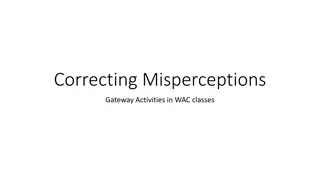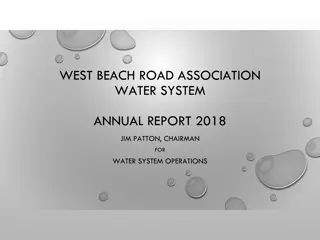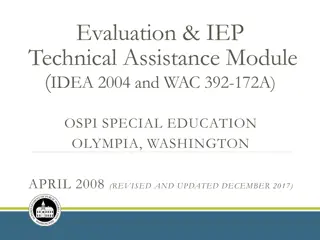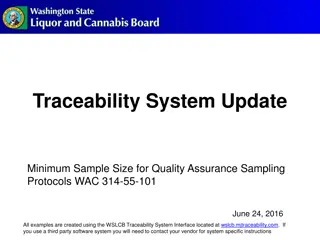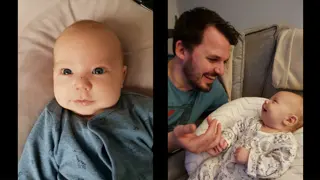
Academic and Social Outcomes of Multiple Art Experiences
Explore the impact of multiple field trips to cultural institutions on students' academic performance and social-emotional development. Results indicate positive effects on test scores, behavior, engagement, and perspective taking. Valuable insights for educators and policymakers.
Download Presentation

Please find below an Image/Link to download the presentation.
The content on the website is provided AS IS for your information and personal use only. It may not be sold, licensed, or shared on other websites without obtaining consent from the author. If you encounter any issues during the download, it is possible that the publisher has removed the file from their server.
You are allowed to download the files provided on this website for personal or commercial use, subject to the condition that they are used lawfully. All files are the property of their respective owners.
The content on the website is provided AS IS for your information and personal use only. It may not be sold, licensed, or shared on other websites without obtaining consent from the author.
E N D
Presentation Transcript
Does Art Make You Smart: The Effect of Multiple Art Experiences on Academic and Social Emotional Outcomes Year 2 Results Heidi H. Erickson Jay P. Greene, Angela R. Watson, and Molly I. Beck
Overview Randomly assign classes of 4thand 5thgraders to receive 3 culturally enriching field trips throughout the school year and measure the impact on student social-emotional and academic outcomes. Results: Increase in math and ELA test scores Decrease in behavioral infractions Increase in school engagement Increase in social perspective taking and tolerance Increase survey effort for girls Null effect for art consumption & participation
Motivation: Field trips are a long standing tradition for schools Increase in schools canceling field trips (Ellerson & McCord, 2009) Teachers report decline in arts education and field trip, particularly among disadvantaged students (Government Accountability Office, 2009) Principal reported pressure from accountability standards and tight budgets Cultural institutions report fewer student groups attending and that adult attendance at art institutions is also declining (Rabkin & Hedberg, 2010)
Previous literature Observational studies Students involvement in the arts is associated with higher academic performance (Ruppert, 2006; J gar and M llegarrd, 2017) Meta-analysis on arts integration programs find 4 percentage point increase in achievement (Ludwig, Boyle, & Lindsay, 2017) Student who attend multiple cultural institutions experienced academic benefits in the short term (Lacoe, Painter, & Williams, 2016) Student experience increased critical thinking, creative thinking and human connection from a single art museum visit (RK&A, 2018) Gold standard studies Students randomly assigned to receive a field trip to an art museum experienced an increase in tolerance, critical thinking, and desire to consume art (Greene et al., 2014; Bowen, Greene, & Kisida, 2014; Kisida, Greene, & Bowen, 2014) Student randomly assigned to attend live theater demonstrated higher levels of content knowledge, tolerance, and social perspective taking (Greene et al, 2018)
Research Question Do students experience social emotional and academic benefits from multiple field trips to cultural institutions? What we add to the literature 1. Experimental design 2. Multiple trips to 3 different art institutions 3. Large, urban school district serving primarily minority and low income students 4. Survey and administrative data for multiple years Hypotheses- Year 1 Expect positive gains in social emotional constructs such as tolerance and social perspective taking Expect positive gains in student desire to consume arts Expect no significant effect in academic achievement Hypotheses- Year 2 Expect increase in school engagement
Research Design: Randomized Control Trial Randomly assign 4thor 5th grade students to serve as treatment or control Cohort 1 4 schools- 4th& 5thgrade Cohort 2 4 original schools- 4thgrade 6 new schools- 4th& 5th grade Treatment Assignment-Year 2 School 1 School 5 4thTreatment 5thControl 6thTreatment- Prior School 2 4thTreatment 5thControl 6thTreatment- Prior School 3 4thControl 5thTreatment- Double 6thControl School 4 4thControl 5thTreatment- Double 6thControl 4thTreatment 5thControl School 6 4thTreatment 5thControl School 7 4thTreatment 5thControl School 8 4thControl 5thTreatment School 9 4thControl 5thTreatment School 10 4thControl 5thTreatment Cohort 1 Cohort 2
Research Design: Randomized Control Trial Treatment: Field trips to Atlanta Symphony Orchestra, Alliance Theater, and High Museum of Art Control: Business as usual 4th& 5th Grade Randomized Follow-up Survey in Spring Survey in Fall 3 Field Trips
Data 10 elementary schools and 1 middle school in a large urban school district ~1,400 Students Student Surveys Interest in art consumption and participation Social emotional measures School Engagement Survey Effort Non-response and careless answers Administrative records Demographics, end of year test scores, courses & grades, attendance, discipline records
Pre-Treatment Comparisons of Treatment and Control Groups Control (mean) Demographics: Age in years 10.48 Female 51.21% Black or AfricanAmerican 98.82% Students with Disabilities 15.50% Baseline Standardized Test Scores ELA -0.35 Math -0.32 All Tests -0.37 Baseline Discipline Measures Infractions 0.12 Suspensions 0.04 Precent Absent 4.47% Careless Answers 0.15 "School is Boring" 0.04 Social Perspective Taking 0.04 Tolerance "Different Opinions" 0.02 Composite Cultural Consumption -0.05 Composite Cultural Participation 0.03 Previously attended WAC 75.10% Previously attended Alliance Theater 32.10% Previously attended Atlanta Symphony 39.74% Previously attended High Museum of Art 49.03% *** p<0.01, ** p<0.05, * p<0.1 Treatment (mean) Difference (T-C) Variables Observations 10.59 51.14% 99.32% 15.27% 0.11 -0.07% 0.50% -0.23% 1135 1363 1018 1228 -0.31 -0.28 -0.34 0.04 0.04 0.03 1202 1201 1205 0.12 0.06 4.58% 0.07 0.00 0.09 0.08 0.14 0.05 80.61% 30.84% 47.95% 52.38% 0.00 0.02 0.11% -0.08 -0.04 0.05 0.06 0.19*** 0.02 5.51%* -1.26% 8.21%** 3.35% 1363 1363 1228 1222 1193 1212 1206 1222 1222 1181 1211 1216 1133
Research Methodology Randomized Control Trial: Compare students who were randomly assigned to receive 3 art related field trip to control students who received business as usual Average Treatment Effect ???= ?0+ ?11???????+ ?22???????+ ?3????????+ ?4??????????+ ???5+ ??+ ??? ??is a vector of student characteristics Baseline test scores Gender Student grade ??is a fixed effect for each school Standard errors are clustered at the teacher level Student random effects are included to adjust for cohort 1 students in both years
Treatment effect on test scores, infractions, and school engagement Math and ELA Test Scores Combined Cohort 1 Infractions "School is Boring" Cohort 2 Combined Cohort 1 Cohort 2 Combined Cohort 1 Cohort 2 1st Treatment 0.060 (0.042) 0.060 (0.092) 0.119* (0.066) 0.857*** (0.018) 0.154** (0.068) 0.166* (0.090) 0.128** (0.064) 0.858*** (0.024) 0.027 (0.057) 0.049 (0.050) -0.011 (0.103) -0.570** (0.240) 0.037 (0.076) 0.024 (0.109) -0.622*** (0.222) 0.072 (0.078) 0.000 (0.079) 0.084 (0.115) -0.327* (0.177) 0.001 (0.032) -0.060 (0.102) 0.088 (0.137) -0.425** (0.179) -0.035 (0.040) 0.070 (0.109) 2nd Treatment Previous Treatment Pre Composite Test Score 0.850*** -0.159*** -0.171*** (0.021) (0.036) 0.644*** (0.156) -0.111*** (0.035) 0.606*** (0.152) -0.000 (0.042) (0.060) 0.780*** (0.230) Pre Infraction Count Pre "School is boring" 0.287*** (0.036) -0.110* (0.065) 0.080 (0.136) 1,176 919 0.234*** (0.048) -0.070 (0.103) 0.101 (0.153) 657 400 0.329*** (0.040) -0.176** (0.075) Female 0.008 (0.035) -0.022 (0.040) 1,493 1,130 0.050 (0.051) 0.038 (0.044) 817 454 -0.007 (0.031) -0.117** (0.053) 0.952*** (0.206) 1,687 1,205 -0.059 (0.079) 0.985*** (0.189) 964 482 -0.161*** (0.056) Grade 6 Observations (N) Number of Students Fixed effects for the ten elementary schools are included in each model. Standard errors clustered at the teacher level are in parentheses. Student random effects are included when students are observed in their first and second treatments or their first and previous treatment. *** p<0.01, ** p<0.05, * p<0.1 889 889 950 950 690 690
Treatment effect on Tolerance, SPT, Survey Effort Social Perspective Taking Combined Cohort 1 Carelessness Cohort 1 Different Opinions Combined Cohort 1 Cohort 2 Cohort 2 Combined Cohort 2 1st Treatment 0.112* (0.058) 0.165 (0.102) -0.149 (0.200) 0.116 (0.089) 0.163 (0.125) -0.168 (0.211) 0.087 (0.075) 0.172 (0.107) -0.076 (0.239) 0.279 (0.341) 0.276* (0.155) -0.045 (0.265) 0.388 (0.357) 0.063 (0.130) 0.039 (0.090) 0.138 (0.211) 0.065 (0.164) -0.243** (0.107) -0.374* (0.223) 0.067 (0.150) 0.021 (0.095) 0.186 (0.180) 0.096 (0.169) -0.367** (0.149) -0.495** (0.232) -0.033 (0.173) 0.136 (0.109) 2nd Treatment Previous Treatment 1st Treat*Female -0.187 (0.138) 2nd Treat*Female Prev Treat*Female Pre "Different Opinions" 0.174*** (0.045) 0.188*** (0.063) 0.153*** (0.051) Pre SPT 0.433*** (0.063) 0.274*** (0.092) 0.581*** (0.055) Pre Carelessness 0.343*** (0.030) -0.144*** (0.033) 0.024 (0.074) -0.385*** (0.103) 1,211 946 0.296*** (0.037) -0.083* (0.044) 0.087 (0.108) -0.371*** (0.091) 675 410 0.406*** (0.041) -0.172*** (0.039) 0.009 (0.082) Pre Composite Test Score 0.161*** (0.033) 0.282*** (0.068) -0.307* (0.175) 1,187 927 0.181*** (0.047) 0.335*** (0.082) -0.317* (0.191) 665 405 0.153*** (0.043) 0.276*** (0.089) 0.122* (0.064) 0.204* (0.123) 0.018 (0.289) 290 238 0.183 (0.111) 0.141 (0.195) 0.065 (0.305) 149 97 0.106 (0.077) 0.166 (0.146) Female Grade 6 Observations (N) Number of Students Fixed effects for the ten elementary schools are included in each model. Standard errors clustered at the teacher level are in parentheses. Student random effects are included when students are observed in their first and second treatments or their first and previous treatment. *** p<0.01, ** p<0.05, * p<0.1 695 695 186 186 713 713
Summary Evidence of academic and social emotional benefits from art exposure First study to show increased effects from multiple treatments and sustained effects past treatment Effects appear to be driven by cohort 1 No effect on desire to consume art Next Steps: Year 3 Larger sample with more dosage variation 6 new elementary schools for a total of 16 New cohort at 6 schools from year 2 Another cohort of students will have double treatment More students in 6th grade
Thank You Questions or Comments Heidi H. Erickson hh018@email.uark.edu
Supplementary Information
Sample Items: Social Perspective Taking How often do you attempt to understand your friends better by trying to figure out what they are thinking? How often do you try to think of more than one explanation for why someone else acted as they did? Overall, how often do you try to understand the point of view of other people? How often do you try to figure out what emotions people are feeling when you meet them for the first time? In general, how often do you try to understand how other people view the situation?
Sample Items: Art Consumption If your friends or family wanted to go to an art museum, how interested would you be in going? How interested are you in visiting an art museum? Visiting art museums is fun. I plan to visit art museums when I am an adult. Art is interesting to me. I feel like I don t belong when I m at an art museum. I feel comfortable talking about art. I would tell my friends that they should visit an art museum. Would you like more art museums in your town? Do you think your friend would enjoy a field trip to an art museum (such as the High Museum of Art)?
Benefits from Field Trips Based off past literature Cultural consumption and participation (Greene et al, 2014; Greene et al, forthcoming) Social Perspective Taking (Gehlbach et al., 2008; Greene et al., forthcoming) New to our project Administrative Records Test scores Test scores, attendance, course selection, grades, discipline records Survey effort as a proxy for student engagement Careless answers and item non-response (Zamarro et al., 2016; Hitt, Trivitt, Cheng, 2016) Hypotheses Expect positive gains in social emotional constructs such as social perspective taking Expect positive gains in student desire to consume arts Expect no significant effect in academic achievement



